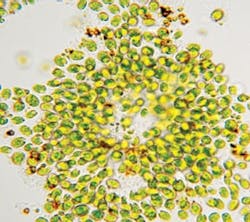About the author: Marc Eeckhaut is executive vice president, Marketing and Technology, for Global Water Eng. Eeckhaut can be reached at [email protected].
Global Water Engineering (GWE) is investigating whether micro algae production can successfully be used for nutrient removal of industrial effluents that have been submitted to anaerobic digestion.
Jean Pierre Ombregt, CEO of GWE, said it is a logical extension of activities in the field of environmentally friendly solutions for wastewater treatment and for the treatment of the liquid fraction of digestate from solid waste digesters.
Advanced anaerobic technology already is being used globally in applications where industry has a biological waste stream; wastewater with high organic carbon; or chemical oxygen demand (COD) of natural origin that can be broken down into biogas by anaerobic bacteria.
The technology—in place at more than 300 food, beverage, agriculture and processing plants worldwide—simultaneously cleans the water to high-discharge standards while producing biogas (methane), which can be used to generate renewable energy or to fuel boilers and other factory plant fuel consumers. Individual users of this technology are saving a substantial amount of money a year with this technology and typically achieving payback of plant investment within two years.
“Anaerobic wastewater treatment already is a proven environmental winner as an effective and economical way to remove COD and BOD out of industrial effluents. But it does not remove—or only marginally removes—nutrients such as nitrogen and phosphorus,” Ombregt said. “Anaerobic treatment also is a proven producer of huge amounts of valuable biogas traditionally used for steam production, but more and more for green power production. But we also know that the exhaust gases from the biogas engines (CHP units) contain massive amounts of carbon dioxide.”
Exploring Algae
Besides water, algae require three things to grow: carbon dioxide, nutrients and photons (light).
“The two first factors are readily available in the effluents, light being the limiting factor. Indeed, light penetration in algae suspensions is problematic and occurs only in the first centimeters,” Ombregt said.
Three main reactor types for the production of algae include open raceway ponds, tubular photo bioreactors and flat panel photo bioreactors.
Open raceway ponds already are being used in big algae farms where land is not an issue. Their shallow depth and sensitivity to ambient temperature makes them suitable for hot climates only. On the other hand, the technology is rather simple and easy to maintain.
Tubular photo bioreactors have the advantage of requiring less space and being independent of external weather conditions because they are usually built in greenhouses. On the other hand, they may require cleaning and fouling control on a more or less regular basis.
Flat panel bioreactors have, besides the same advantages of tubular bioreactors, also the advantage of really optimizing exposure to light because their panels move and are re-oriented to follow the position of the sun. GWE’s Executive Vice President of Process and R&D, Pascal Pipyn, said these flat panel photo bioreactors (PBRs) are the champions of light utilizations and productivity per surface unit.
Both tubular and flat panel PBRs can be installed in colder climates and the photoperiod can be prolonged in wintertime by using artificial light produced by low power-consuming LED lamps. The required power for lighting is produced by the biogas engines during nighttime, when the value of the power is minimal.
“Algae have an excellent nutrient value, as they contain essential amino acids and proteins that make them, once dewatered or dried, a valuable feedstock for crustaceans, shellfish, fish and mammals. Chlorella and Spirulina are already used in fisheries, for instance,” Pipyn said. “If the nutrients can be extracted from the wastewater of the food industry, they can be used for the production of high-value antioxidants produced by special red algae as Haematococcus pluvialis. The added value of the antioxidant Astaxanthin extracted from that alga is fabulous, as it is a powerful antioxidant and thus welcome in the battle against diseases such as cancer.
“Dunaliella Salina, on the other hand, has a high carotene content and the highest salinity tolerance, which makes it interesting to look at.”
Continued R&D
Research and development is being conducted on applications where carbonaceous pollution is turned into energy and nutrients, and the carbon dioxide of the exhaust gases are turned into algae biomass, which can be used either as feedstock or returned to the digester for more biogas.
“By doing so, the universally recognized limit of 350 cu Nm of methane per ton of COD converted would be easily surpassed, turning what was once considered a miracle into a reality,” said Arjan den Breejen, executive vice president of sales for GWE.
Download: Here
